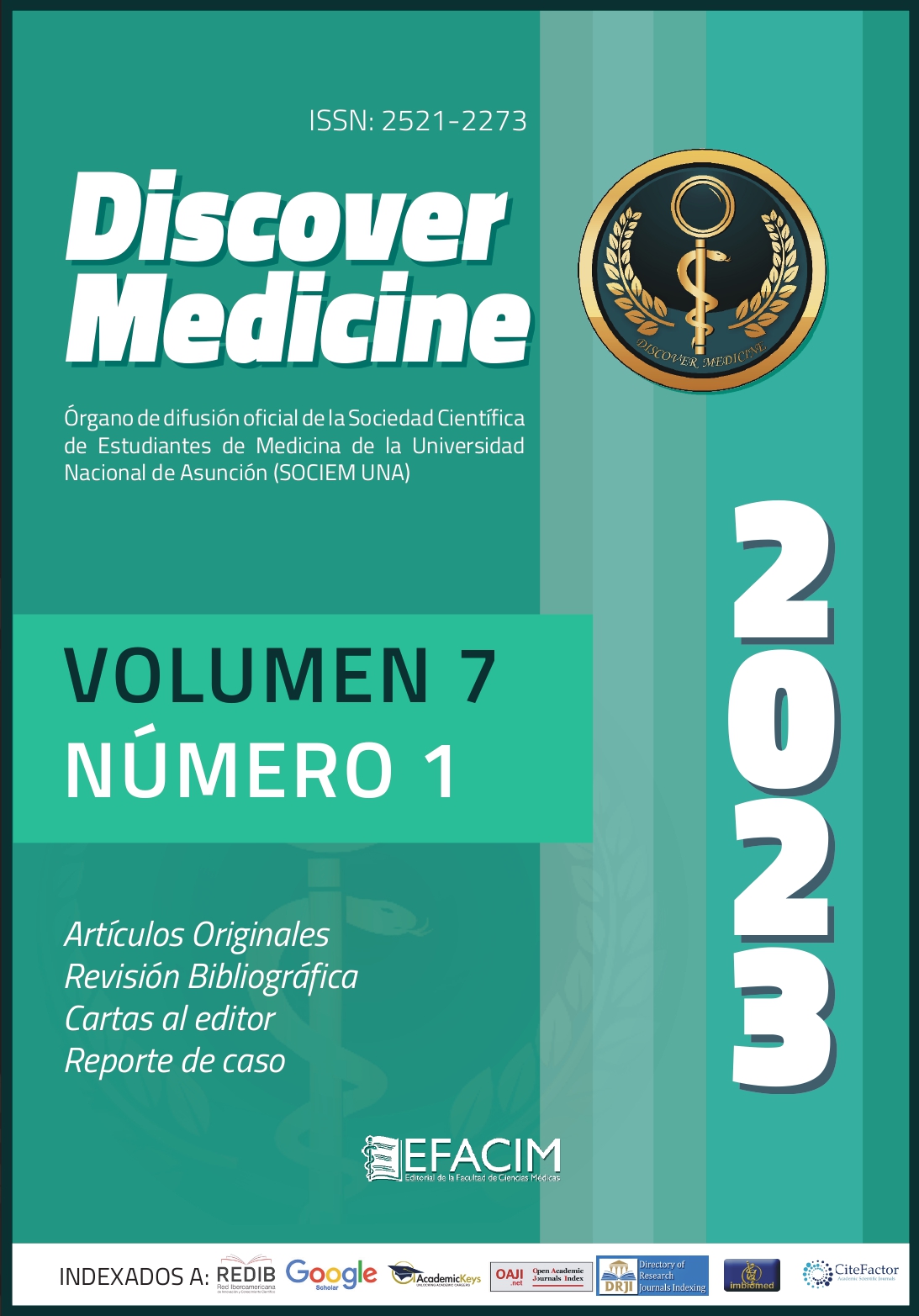Resumen
Introducción: Una situación preocupante ha sido la evolución registrada por el aumento de infectados por el nuevo coronavirus cuyas siglas COVID-19 obedecen al año en el que ha sido descubierto, en la ciudad de Wuhan, China. En América, la mayoría de las muertes por COVID-19 ocurrieron en personas de 70 años o más, seguidas de personas entre 60 y 69 años. Siendo los adultos mayores una población muy vulnerable.
Objetivo: Determinar el estado nutricional y características de la alimentación en adultos mayores del Hogar de Reposo Simeona post pandemia por covid durante los meses de agosto a septiembre del año 2022.
Metodología: Estudio observacional descriptivo de corte transverso en adultos mayores de 60 años, en quienes se aplicó una encuesta sobre datos sociodemográficos y estado nutricional a través del Índice de masa corporal (IMC) según parámetros de la Organización Panamericana de la Salud (OPS).
Resultados: Los resultados de datos sociodemográficos arrojaron que el 53.33 % de la población estudiada correspondió al sexo masculino y 46,67% al femenino. En cuanto a las características de la alimentación el 100% refirió alimentarse vía oral, respecto a los resultados de la valoración antropométrica, el diagnóstico nutricional que predominó fue la desnutrición (66,67%) según parámetros del IMC (Organización Panamericana de la Salud).
Conclusión: La pandemia Covid 19 constituyó un desafío para todos los sectores del área de la salud, afectando especialmente a personas con enfermedades de base y adultos mayores. La desnutrición entre los adultos mayores del hogar Simeona demuestra una alta prevalencia post pandemia, la planificación de estrategias nutricionales constituye un pilar fundamental para la resistencia contra las complicaciones y disminución de la morbimortalidad en este grupo especialmente vulnerable.
Referencias
Trilla A. Un mundo, una salud: la epidemia por el nuevo coronavirus COVID-19. Med Clin (Bar). 2020;154(5):175-77.
Solis CU.Coronavirus y enfermedades reumáticas, suposiciones, mitos y realidades. Rev Cub de Reu. 2020;22(2):1-6.
Vega Rivero JA, Ruvalcaba Ledezma JC , Hernández Pacheco I, Acuña Gurrola MR, López Pontigo L. La salud de las personas adultas mayores durante la pandemia de COVID-19. JONNPR. 2020;5(7):726-39.
Organización Mundial de la Salud. Organización Panamericana de la Salud. [citado 20 abril 2021]. Disponible en: https://www.paho.org/es/noticias/30-9-2020-personas-mayores-60-anos-han-sido-mas-afectadas-por-covid-19-americas
Ministerio de Salud Pública y Bienestar Social. [citado 20 abril 2021]. Disponible en: https://www.lanacion.com.py/pais/2020/12/08/mayor-letalidad-por-covid-19-en-paraguay-se-da-en-mayores-de-80-anos/
Falconi D y cols. Nutrición y enfermedades crónicas no trasmisibles del adulto mayor del club mi esperanza del Establecimiento de Salud I-3, Corrales – Tumbes, 2020. [tesis]. Perú: Universidad Nacional de Tumbes;2020.
Organización Mundial de la Salud. Guía para las mediciones físicas (Step 2) Vigilancia STEPS de la OMS [Internet]. Switzerland; [citado 2 de octubre de 2022]. Disponible en: https://www.who.int/ncds/surveillance/steps/en/
Navarro E, Longo EN, González AF. Técnica dietoterápica. 3ª ed. Cap. 15. El plan de alimentación hiposódico. Ciudad Autónoma de Buenos Aires: El Ateneo,2019.
Olivares C. Disfagia en adulto mayor: revisión de la evidencia en el manejo de la disfagia en población geriátrica. Universidad de Chile. Santiago, 2016. Disponible en: https://repositorio.uchile.cl/bitstream/handle/2250/140955/Disfagia_en_Adulto_Mayor.pdf?sequence=1
D. Águila-Gordo,J.Martínez-delRio,M.Negreira-Caama, et al. Enfermedad cardiovascular tras infección por SARS-CoV-2 en pacientes ancianos. Resultados del seguimiento anual de una cohorte de supervivientes. Revista Española de Geriatría y Gerontología. 57(2022)100–104. Disponible en: https://www.elsevier.es/es-revista-revista-espanola-geriatria-gerontologia-124-pdf-S0211139X21001748
Rico M, Oliva D, Vega G. Envejecimiento: algunas teorías y consideraciones genéticas, epigenéticas y ambientales. 2018;56(55).
Troncoso Pantoja Claudia. Alimentación del adulto mayor según lugar de residencia. Horiz. Med. [Internet]. 2017 Jul [citado 2023 Ene 16] ; 17( 3 ): 58-64. Disponible en: http://www.scielo.org.pe/scielo.php?script=sci_arttext&pid=S1727-558X2017000300010&lng=es. http://dx.doi.org/10.24265/horizmed.2017.v17n3.10
Bermejo RV, Garcí IA, Galera DM, de las Heras Rodríguez M, Torramadé JP. Prevalencia de desnutrición en personas mayores institucionalizadas en España: Un análisis multicéntrico nacional. Nutr Hosp. 2015;31(3):1205–
Maguiña Vargas Ciro, Gastelo Acosta Rosy, Tequen Bernilla Arly. El nuevo Coronavirus y la pandemia del Covid-19. Rev Med Hered [Internet]. 2020 Abr [citado 2023 Ene 17] ; 31( 2 ): 125-131. Disponible en: http://www.scielo.org.pe/scielo.php?script=sci_arttext&pid=S1018-130X2020000200125&lng=es. http://dx.doi.org/10.20453/rmh.v31i2.3776
Velázquez-Alba M, Cabrer-Rosales MF, Irigoyen Camacho ME. Importancia de la nutrición en pacientes adultos mayores con infección por covid-19. Revista Facultad Nacional de Salud Pública. Universidad de Antioquia. Disponible en: https://doi.org/10.17533/udea.rfnsp.e344210
Plata Zambrano, S. Síndrome post-covid y su relación con el estado nutricional: una revisión de literatura. Pontificia Universidad Javeriana Facultad de Ciencias. Carrera de Nutrición y Dietética. Bogotá, d.c. 2022. Disponible en: https://mail.google.com/mail/u/0/#inbox/QgrcJHrjBRLDSnPvPGXxxrqMkTJGTcRbwtQ?projector=1&messagePartId=0.1
López, D., Posada, C. y Savino, P. 2022. Síndrome poscovid-19 y nutrición: una perspectiva de manejo. Medicina. 44, 1 (abr. 2022), 87–98. DOI:https://doi.org/10.56050/01205498.1664
Buitrago-Gómez N, Zambrano-Urbano J, Muñoz-Realpe J, Ocampo-Chaparro JM, Hernández-Arango C, Lesmes-Duque MC, et al. Prevalencia y factores asociados con infección por covid-19 en adultos mayores institucionalizados. Duazary. 2022abril; 19(2): 116-128. Doi: https://doi.org/10.21676/2389783X.4691
Yang J, Zheng Y, Gou X, Pu K, Chen Z, Guo Q, Ji R, Wang H, Wang Y, Zhou Y. Prevalence of comorbidities and its effects in patients infected with SARS-CoV-2: a systematic review and meta-analysis. Int J Infect Dis. 2020 May;94:91-95. doi: 10.1016/j.ijid.2020.03.017. Epub 2020 Mar 12. PMID: 32173574; PMCID: PMC7194638.
Idacochea I. Estado nutricional y hematológico post covid 19 en adultos mayores. FIPCAEC (Edición. 32) Vol. 7, No 4, Octubre-Diciembre2022, pp. 1417-1435, ISSN: 2588-090X Doi: https://doi.org/10.23857/fipcaec.v7i4
Aranda Rubio Y, Cuesta Castellón G, Neira Martín B, Gómez-Pavón FJ. Disgeusia post-COVID-19: nueva causa de negativa a la ingesta en el paciente anciano [Post-COVID-19 dysgeusia: New refusal to eat in elderly patients]. Rev Esp Geriatr Gerontol. 2022 Jan-Feb;57(1):57-58. Spanish. doi: 10.1016/j.regg.2021.05.008. Epub 2021 May 24. PMID: 34315615; PMCID: PMC8141694.

Esta obra está bajo una licencia internacional Creative Commons Atribución-NoComercial-SinDerivadas 4.0.
Derechos de autor 2023 Johana Vanessa Meza Paredes, Lourdes Alicia Ortiz Soria, Araceli Olmedo Pavón

